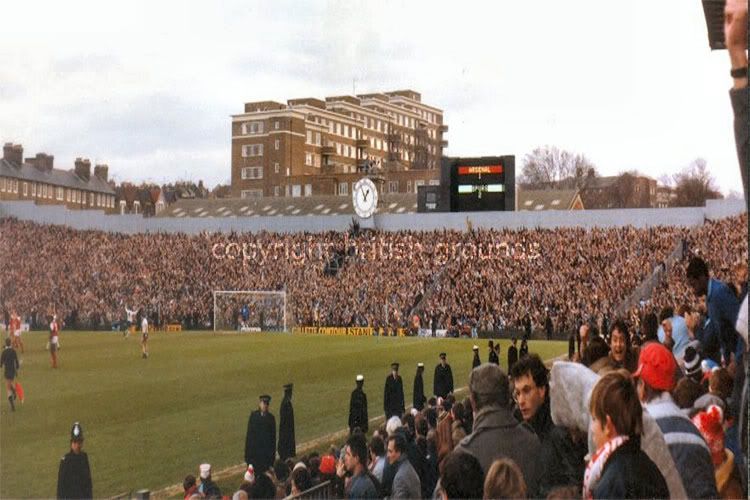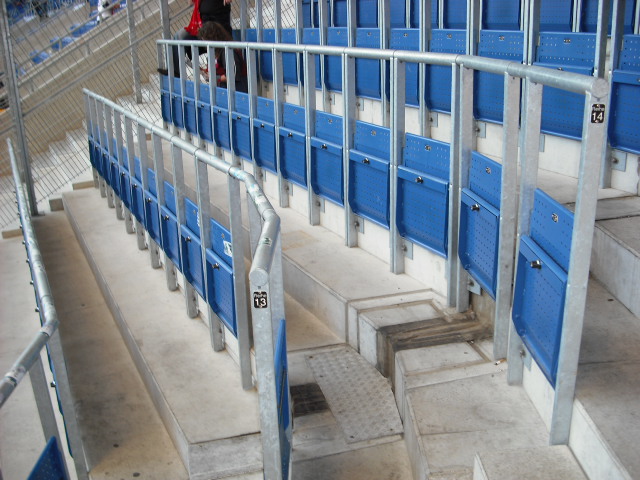A statement of opinion
- and motion for future debate - on "safe standing areas"
in top-flight football grounds in EnglandandWales was recently tabled in the Assembly. It was raised by Leader of the Opposition, Andrew
Davies (Con, South Wales Central) and co-sponsored by AMs from all
the other parties.
The motion calls for the Assembly to lobby Westminster in favour of the reintroduction of terracing (initially via a trial of "safe standing"), noting that an appetite for reintroduction "exists amongst football supporters across Wales and beyond."
Why (and how) terracing was phased out
There are probably two main reasons
as I see it : difficulties in policing hooliganism and the
Hillsborough disaster.
"Old school" terracing in British football grounds usually consisted of steps with railings for supporters to lean against. When football hooliganism took hold in the 70s, fences were also placed in front of the stands to prevent objects being thrown, make policing easier and prevent pitch invasions.
There was very little regulation of the numbers allowed on terracing and it was pretty much first-come, first served. There was also culture amongst authorities – especially police - of football supporters, quite literally, being treated and herded like livestock. So, far from being "safe standing" it was very much "unsafe" by modern standards.
In 1981, during an FA Cup semi-final between Tottenham and Wolves, there was a crush in terracing at the Leppings Lane stand of Hillsborough Stadium in Sheffield amongst Tottenham fans. Nobody was seriously injured, though 38 people suffered injuries like broken limbs.
Then in 1989, at the same end of the stadium – practically unchanged from 1981 - 94 Liverpool fans were crushed to death, with two dying later. Police opened an exit gate to ease a crowd build up outside the ground, allowing more Liverpool supporters into the already overcrowded terracing.
Police and sections of the tabloid media immediately blamed the supporters and hooliganism for the disaster – based off the account of senior police officers and a local MP. It was only last year, after 23 years of campaigning, that Liverpool supporters were formally absolved of any blame. It was even revealed that as many as 41 people would have survived had the right actions been taken at the time by authorities. Criminal prosecutions against the police are now likely.
Following the disaster, Justice Taylor produced a report that recommended terracing be phased out at all top-flight (First Division, then Premier League) grounds by the 1994-95 season, and that all ticketed supporters would have a seat.
The report didn't actually state that standing was unsafe, but it was the government and football authorities that pressed for the maximum changes themselves.
Since then, many clubs have built completely new all-seater stadia – including both Cardiff City and Swansea City. Many football supporters, however, support the introduction of "safe standing areas", allowing terracing to make a comeback at top-flight grounds.
The rules don't apply to non-football stadiums as far as I can tell – hence why there's still terracing at rugby grounds and racecourses - but the rules still apply to football grounds that host sports like rugby. It also doesn't apply to smaller, lower league clubs. However, even Welsh Premier clubs need a minimum number of seats at their grounds.
What is safe standing?
German football clubs have safe standing as standard in most, if not all, top-flight Bundesliga stadiums.
They
usually take the form of a fence, where a seat folds away to allow a
person to stand comfortably in the space left (aka "rail
seats"). It has an advantage as it means stadiums can be quickly
converted to all-seater for European competitions (which is a
requirement).
Crowds can be monitored and controlled much easier in rows of folded
away seats than on glorified steps. It isn't a free for all as old terracing used to be.
Some of the larger stands can accommodate tens of thousands of supporters by themselves quite safely. For example, the seated-only capacity of Borussia Dortmund's Westfalenstadion is around 66,700. Its seated and standing capacity is just under 81,000 – a difference of around 18%.
If a similar percentage were applied to Cardiff City Stadium, capacity would rise from 26,800 to around 31,500. Similarly, Swansea's Liberty Stadium could go from 20,750 to just under 24,500.
What are the benefits and disadvantages?
Many football clubs already have a problem with fans standing in seating areas, and stewards usually have to tell supporters to sit down (or "siddaaahn" at London grounds). It ruins the view for those behind, encouraging them to stand too, rendering the seats redundant. Obviously if fans had a choice whether to sit or stand in parts of the ground it might solve this problem.
It's been argued that creating a more comfortable environment via seating reduced hooliganism, and by creating a "family friendly" atmosphere, encouraged more women and children to attend matches. But it's not as if entire grounds would be converted to safe standing, probably only sections of stands. Plus, Bundesliga clubs seem to have no problem attracting women and children to games - or even refereeing. It's also worth pointing out there were plenty of women and children amongst the Hillsborough disaster victims.
People like to think that hooliganism's gone away, but it's still there – even in Germany - just not as prominent. Fights are usually organised beforehand rather than sporadic and take place away from stadiums rather than in the stadiums themselves. There's a risk that reintroducing terracing might encourage these "old school" elements back, but I think that's a little hysterical. Policing and crowd control have improved massively since the Hillsborough disaster.
But if the police do feel that they need extra resources to police games, then they could end up charging more to clubs that are already in financial trouble. There would presumably be an up-front cost in establishing new standing areas in all-seater stadiums too, as well as possibly having to re-apply for crowd safety certificates.
If you're not paying for a seat, it might justify lower ticket prices, offset by increasing the overall stadium capacity. German clubs have some of the lowest ticket prices amongst Europe's "big leagues" – as low as €12 (£10) in standing areas - and the highest average attendances. England however, has some of the highest average ticket prices, sometimes much higher than average for London-based clubs.
There's also no guarantee that clubs would charge less. If they wanted to market it as some sort of "experience" - i.e. if Cardiff City created some "Grange End Experience" using safe standing - they might even consider putting prices up! Especially if sitting is that unpopular and they can't meet demand with supply.
Could the Assembly/Welsh Government do it themselves?
Obviously I believe a decision over Welsh stadiums should be taken in Wales. It's unclear, but the likely answer is no, hence why the motion is to "lobby the UK Government".
Sport is supposed to be devolved. However, an area like safe standing is a little bit obtuse as it covers criminal justice (non-devolved), public safety (don't know) and building regulations (which were devolved last year).
The only clubs this would impact are Welsh sides playing in the English pyramid, and that's administrated from England anyway, so this is probably going to have to be led by Westminster.
Scotland wasn't bound by the findings of the Taylor Report, or subsequent legislation, and the responsibility rests fully with the Scottish Parliament. The Scottish Premier League did institute a requirement for top-flight clubs to have all-seater stadia, but those requirements are going to be relaxed in the near-future as I understand it.
Now that the Hillsborough victim families are inching towards the "justice" they've been fighting for so long for, it's as good a time as any to revisit this issue. It probably boils down to simply giving supporters the choice whether to sit or stand.
If standing does come back at top-flight grounds, then it has to be as safe as possible, and supporters themselves are going to have to watch their own behaviour. All those calling for its return need to remember why it was phased out in the first place.
The motion calls for the Assembly to lobby Westminster in favour of the reintroduction of terracing (initially via a trial of "safe standing"), noting that an appetite for reintroduction "exists amongst football supporters across Wales and beyond."
Why (and how) terracing was phased out
 |
| Terracing used to be a popular way to allow as many supporters as possible to attend games - perhaps to the detriment of crowd safety. (Pic : via footballforums.net) |
"Old school" terracing in British football grounds usually consisted of steps with railings for supporters to lean against. When football hooliganism took hold in the 70s, fences were also placed in front of the stands to prevent objects being thrown, make policing easier and prevent pitch invasions.
There was very little regulation of the numbers allowed on terracing and it was pretty much first-come, first served. There was also culture amongst authorities – especially police - of football supporters, quite literally, being treated and herded like livestock. So, far from being "safe standing" it was very much "unsafe" by modern standards.
In 1981, during an FA Cup semi-final between Tottenham and Wolves, there was a crush in terracing at the Leppings Lane stand of Hillsborough Stadium in Sheffield amongst Tottenham fans. Nobody was seriously injured, though 38 people suffered injuries like broken limbs.
Then in 1989, at the same end of the stadium – practically unchanged from 1981 - 94 Liverpool fans were crushed to death, with two dying later. Police opened an exit gate to ease a crowd build up outside the ground, allowing more Liverpool supporters into the already overcrowded terracing.
Police and sections of the tabloid media immediately blamed the supporters and hooliganism for the disaster – based off the account of senior police officers and a local MP. It was only last year, after 23 years of campaigning, that Liverpool supporters were formally absolved of any blame. It was even revealed that as many as 41 people would have survived had the right actions been taken at the time by authorities. Criminal prosecutions against the police are now likely.
Following the disaster, Justice Taylor produced a report that recommended terracing be phased out at all top-flight (First Division, then Premier League) grounds by the 1994-95 season, and that all ticketed supporters would have a seat.
 |
| The fallout from the 1989 Hillsborough disaster saw terracing phased out over the course of several years. (Pic : The Guardian) |
The report didn't actually state that standing was unsafe, but it was the government and football authorities that pressed for the maximum changes themselves.
Since then, many clubs have built completely new all-seater stadia – including both Cardiff City and Swansea City. Many football supporters, however, support the introduction of "safe standing areas", allowing terracing to make a comeback at top-flight grounds.
The rules don't apply to non-football stadiums as far as I can tell – hence why there's still terracing at rugby grounds and racecourses - but the rules still apply to football grounds that host sports like rugby. It also doesn't apply to smaller, lower league clubs. However, even Welsh Premier clubs need a minimum number of seats at their grounds.
What is safe standing?
German football clubs have safe standing as standard in most, if not all, top-flight Bundesliga stadiums.
 |
| An example of "rail seats" at TSG Hoffenheim (I think) (Pic : the92.net) |
Some of the larger stands can accommodate tens of thousands of supporters by themselves quite safely. For example, the seated-only capacity of Borussia Dortmund's Westfalenstadion is around 66,700. Its seated and standing capacity is just under 81,000 – a difference of around 18%.
If a similar percentage were applied to Cardiff City Stadium, capacity would rise from 26,800 to around 31,500. Similarly, Swansea's Liberty Stadium could go from 20,750 to just under 24,500.
What are the benefits and disadvantages?
Many football clubs already have a problem with fans standing in seating areas, and stewards usually have to tell supporters to sit down (or "siddaaahn" at London grounds). It ruins the view for those behind, encouraging them to stand too, rendering the seats redundant. Obviously if fans had a choice whether to sit or stand in parts of the ground it might solve this problem.
It's been argued that creating a more comfortable environment via seating reduced hooliganism, and by creating a "family friendly" atmosphere, encouraged more women and children to attend matches. But it's not as if entire grounds would be converted to safe standing, probably only sections of stands. Plus, Bundesliga clubs seem to have no problem attracting women and children to games - or even refereeing. It's also worth pointing out there were plenty of women and children amongst the Hillsborough disaster victims.
 |
| Would bringing back terracing discourage women and children from attending matches? It's unlikely. (Pic : Kate Laycock via dw.de) |
People like to think that hooliganism's gone away, but it's still there – even in Germany - just not as prominent. Fights are usually organised beforehand rather than sporadic and take place away from stadiums rather than in the stadiums themselves. There's a risk that reintroducing terracing might encourage these "old school" elements back, but I think that's a little hysterical. Policing and crowd control have improved massively since the Hillsborough disaster.
But if the police do feel that they need extra resources to police games, then they could end up charging more to clubs that are already in financial trouble. There would presumably be an up-front cost in establishing new standing areas in all-seater stadiums too, as well as possibly having to re-apply for crowd safety certificates.
If you're not paying for a seat, it might justify lower ticket prices, offset by increasing the overall stadium capacity. German clubs have some of the lowest ticket prices amongst Europe's "big leagues" – as low as €12 (£10) in standing areas - and the highest average attendances. England however, has some of the highest average ticket prices, sometimes much higher than average for London-based clubs.
There's also no guarantee that clubs would charge less. If they wanted to market it as some sort of "experience" - i.e. if Cardiff City created some "Grange End Experience" using safe standing - they might even consider putting prices up! Especially if sitting is that unpopular and they can't meet demand with supply.
Could the Assembly/Welsh Government do it themselves?
Obviously I believe a decision over Welsh stadiums should be taken in Wales. It's unclear, but the likely answer is no, hence why the motion is to "lobby the UK Government".
Sport is supposed to be devolved. However, an area like safe standing is a little bit obtuse as it covers criminal justice (non-devolved), public safety (don't know) and building regulations (which were devolved last year).
 |
| Have wounds healed enough to revisit this issue? (Pic : BBC) |
The only clubs this would impact are Welsh sides playing in the English pyramid, and that's administrated from England anyway, so this is probably going to have to be led by Westminster.
Scotland wasn't bound by the findings of the Taylor Report, or subsequent legislation, and the responsibility rests fully with the Scottish Parliament. The Scottish Premier League did institute a requirement for top-flight clubs to have all-seater stadia, but those requirements are going to be relaxed in the near-future as I understand it.
Now that the Hillsborough victim families are inching towards the "justice" they've been fighting for so long for, it's as good a time as any to revisit this issue. It probably boils down to simply giving supporters the choice whether to sit or stand.
If standing does come back at top-flight grounds, then it has to be as safe as possible, and supporters themselves are going to have to watch their own behaviour. All those calling for its return need to remember why it was phased out in the first place.















